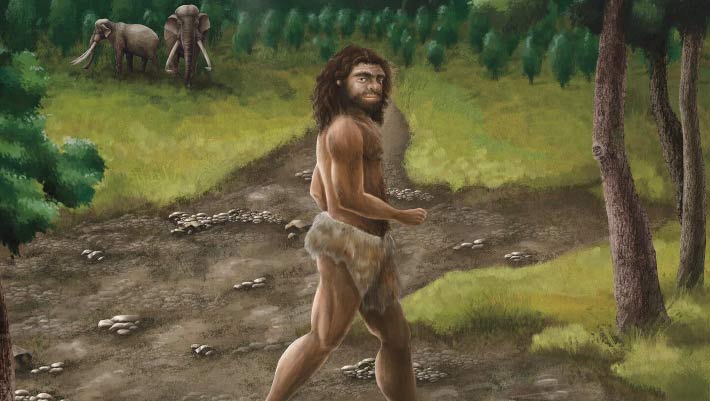Thousands of years ago, ancient Homo sapiens undertook a treacherous journey, crossing hundreds of km of ice over the Bering Strait to the unknown world of the Americas. Now, a new study suggests that these people carried something surprising with them — a variant of the MUC19 gene inherited from Denisovans, which may have helped humans adapt to the challenges of their new home.
An artist’s concept of a Penghu Denisovan walking under the bright Sun during the Pleistocene of Taiwan. Image credit: Cheng-Han Sun.
Modern human genomes contain a small number of archaic variants, the legacy of past interbreeding events with Neanderthals and Denisovans.
Most of these variants are neutral, but some archaic variants found in modern humans have been targets of positive natural selection and may have been pivotal for adapting to new environments as humans populated the world.
American populations encountered a myriad of novel environments, providing the opportunity for natural selection to favor archaic variants in these new environmental contexts.
In new research, a team of scientists led by the University of Colorado, Boulder and Brown University focused on a gene known as MUC19, which is involved in the production of proteins that form saliva and mucosal barriers in the respiratory and digestive tracts.
They found that a Denisovan variant of MUC19 is present in modern Latin Americans with Indigenous American ancestry, as well as in DNA collected from individuals excavated at archeological sites across North and South America.
The frequency at which the gene appears in modern human populations suggests the gene was under significant natural selection, meaning it provided a survival or reproductive advantage to those who carried it.
It’s not clear exactly what that advantage might have been, but given the gene’s involvement in immune processes, it may have helped populations to fight off pathogens encountered as they migrated into the Americas thousands of years ago.
“From an evolutionary standpoint, this finding shows how ancient interbreeding can have effects that we still see today,” said Brown University’s Professor Emilia Huerta-Sánchez.
“From a biological standpoint, we identify a gene that appears to be adaptive, but whose function hasn’t yet been characterized.”
“We hope that leads to additional study of what this gene is actually doing.”
Not much is known about Denisovans, who lived in Asia between 300,000 and 30,000 years ago, aside from a few small fossils from Denisova cave in Siberia, two jaw bones found in Tibet and Taiwan, and a nearly complete skull from China found this year.
The finger fossil from Siberia contained ancient DNA, which enables scientists to look for common genes between Denisovans and modern humans.
Prior research found that a version of a gene called EPAS1 acquired from Denisovans may have helped Sherpas and other Tibetans to adapt to high altitudes.
For this new study, the researchers compared Denisovan DNA with modern genomes collected through the 1,000 Genomes Project, a survey of worldwide genetic variation.
They found that the Denisovan-derived MUC19 gene is present in high frequencies in Latino populations who harbor Indigenous American genetic ancestry.
They also looked for the gene in the DNA of 23 individuals collected from archeological sites in Alaska, California, Mexico and elsewhere in the Americas.
The Denisovan-derived variant was present at high frequency in these ancient individuals as well.
The authors used several independent statistical tests to show that the Denisovan MUC19 gene variant rose to unusually high frequencies in ancient Indigenous American populations and present-day people of Indigenous descent, and that the gene sits on an unusually long stretch of archaic DNA — both signs that natural selection had boosted its prevalence.
They also revealed that the gene was likely passed through interbreeding from Denisovans to another archaic population, Neanderthals, who then interbred with modern humans.
“The findings demonstrate the importance that interbreeding had in introducing new and potentially useful genetic variation in the human lineage,” Professor Huerta-Sánchez said.
“Typically, genetic novelty is generated through a very slow process.”
“But these interbreeding events were a sudden way to introduce a lot of new variation.”
“In this case, that new reservoir of genetic variation appears to have helped modern humans as they migrated into the Americas, perhaps providing a boost to the immune system.”
“Something about this gene was clearly useful for these populations — and maybe still is or will be in the future.”
“We’re hopeful that the recognition of the gene’s importance will spur new research into its function to reveal novel biological mechanisms, especially since it involves coding genetic variants that alter the protein sequence.”
The study was published in the journal Science.
_____
Fernando A. Villanea et al. 2025. The MUC19 gene: An evolutionary history of recurrent introgression and natural selection. Science 389 (6762); doi: 10.1126/science.adl0882
